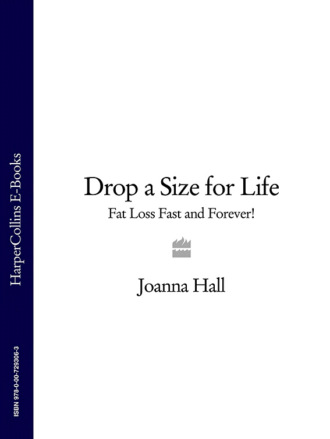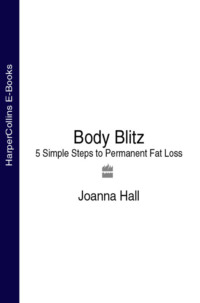
Полная версия
Drop a Size for Life: Fat Loss Fast and Forever!

JOANNA HALL
DROP
A SIZE
FOR LIFE
FAT LOSS FAST AND FOREVER!

CONTENTS
Introduction
Getting Started
How the book works
Section One: Preparing to Drop a Size
Step 1 Train your brain
Step 2 Befriend the mirror
Step 3 Think, say and do as one
Step 4 Make friends with the enemy
Step 5 Establishing the here and now
Step 6 Get on that pedestal
Step 7 Finding the elusive G spot
Section Two: Dropping that Size
The 10 Fundamentals
Follow the Carb Curfew
Eat more fibre
Cut your sodium intake
Fit in some exercise – with and without your trainers
Get savvy about fats
Don’t skimp on the protein
Beware of alcohol – the hidden pound piler
Keep up your water intake
Get to grips with portion control
Follow the 80-20 rule
The drop a size eating plans
The Recipes
Drop a size for life foods
Troubleshooting some commonly asked questions and problems
Section Three: Keeping Your New Size for Life
The child-bearing years
Pregnancy
Reclaiming your body after pregnancy
Midlife
Perimenopause
Menopause
Growing older
by the same author
Copyright
About the Publisher

INTRODUCTION
So you want to drop a size? Well, it’s easy! It simply entails making some changes to your diet and stepping up your activity levels – both of which you’ll learn how to do in this book. Where the real challenge lies is in maintaining that ideal size – not for a week, or a month, or even for a year, but for life.
Imagine how wonderful that would be – to achieve the body shape and size you want now and still have that figure in a decade’s time. Well, you can do it – but, like most things worth having in life, it’s going to take a little time, effort and know-how.
Dieting is a lot like relationships. What we’re looking for in a relationship and what we’re prepared to put into it influence the kind of relationship it will be. Quick-fix diets are the equivalent of a one-night stand: you get what you want fast and it feels great – but it doesn’t last. You may hope for something a little more permanent but inevitably you soon realize that the man or woman of your dreams isn’t all you thought they’d be and your interest wanes. Similarly, that ‘revolutionary’ new diet that was going to get the weight off, once and for all, soon becomes a slog and leaves you feeling disillusioned and disappointed.
Now think of a long-term relationship. Anyone who has experienced a good, lasting partnership knows that it involves a bit of work and upkeep. It’s not always earth-shatteringly exciting, and there are inevitably problems along the way, but it feels right, it makes you happy and, most of all, it feels like a permanent part of your life. That doesn’t mean it doesn’t evolve along the way, however. More than likely, both parties change, or circumstances change, and a period of adjustment follows. The likelihood of long-term success is determined by how you navigate this sometimes tricky road.
This principle applies just as much to your relationship with your body as it does to the one you have with your partner. Things change due to circumstances, ageing, environmental and social factors, the key is to be in tune with – and responsive to – your body’s needs as they arise.
Dropping a size is about weight management, not about fixing a figure on the scales and perceiving anything above that as failure. The clinical definition of successful weight management is that you stay within 20 per cent of the original weight loss. You shouldn’t expect to maintain the exact same weight for life. Weight fluctuates and there are times when it is healthier to gain a little weight; times when life dictates that the effort involved in staying in shape simply can’t be made. Think of it this way: if you want to stay at a weight of 91½ stones for the rest of your life, you’ll need to exercise religiously and eat strictly all the time – but if you aim to stay within 20 per cent of your optimal weight, you can adopt the principles and strategies you’ll learn in this book and still enjoy your life, too.
Let’s go back to relationships for a moment. There are times when we think we’re embarking on the ultimate relationship – ‘the one’ – and it turns out to be just another fly-by-night fling. At first, we can’t stop thinking about our new partner, we want to talk about them all the time, we think about the future, devote loads of time to them. Then, gradually, little problems and disappointments arise, it all becomes a little mundane and we realize that they’re not quite so perfect after all. Generally we carry on with the relationship a little while longer but without really giving it the care and attention it deserves to develop and improve. Inevitably a few weeks later the relationship ends – and the search for Mr Right or Mrs Right begins again.
It’s a familiar enough story – but can you see how similar it is to the quest many of us are on to lose weight? Compare it to the following all-too-common scenario. You’re in the coffee shop with your work colleagues and one of them tells you about this great new diet – it involves bizarre food combinations, no alcohol, no this, no that, no life but hey, it worked for Maggie in accounts and she looks fab! So you decide to leap in and really give this a go – this will be the diet for you! This diet is going to last! One month later, sitting around the same coffee table, you’re back to normal eating. That diet? Well, you lost weight initially, but you really missed your red wine and bread and you felt so devoid of energy that you couldn’t possibly get to aerobics. Now you’re 8 pounds heavier than when you started and a whole dress size bigger. At this point, Maggie from accounts walks past and she’s most definitely gained at least two dress sizes. Ah, well, you’ve heard the Brussels sprouts diet is very good …
Sometimes what we think is the right diet, or the perfect relationship, really isn’t. When it comes to relationships, okay we can’t help it if we fall for the wrong person, or misjudge someone – and hey, we all make mistakes – but as we get older we hopefully learn from our mistakes and begin making better judgements, putting in the right kind of time and effort to the relationships that really could work. So why can’t we seem to do the same with dieting? Many of us just seem to keep making the same mistakes over and over again. We keep choosing these ‘Mr Right’ diets and when we can’t make them work we feel more and more despondent.
This repeated cycle of failure creates self-fulfilling prophecies. In other words, because you’ve failed before, you expect to fail again right from the outset, so you embark on your weight loss regime with ‘I bet this doesn’t work’ in the back of your mind. With this mindset, failure is hardly surprising – and of course having proved that you are a failure, your self-esteem and confidence are further undermined.
This can actually have a negative effect on how you see yourself – on your body image. Research has shown that women who have low self-esteem have a less accurate picture of what their bodies look like than women who are more confident about themselves. Unfailingly, the under-confident women see themselves as larger than they are in reality. So not only does repeating the same mistakes fail to produce results, it may also make you feel worse than you did at the start of the whole process!
Dropping a size for life is about putting an end to this negative cycle of behaviour. This involves learning how to target your efforts to where they’ll really count and about forging and nurturing a positive relationship between your body and your brain. Losing weight isn’t physically hard. You know what you have to do – eat less and exercise more! However, to keep that weight off, you will need to learn how to develop mental strategies and the right mindset so that you can tackle all the challenges that life throws at us – whether it’s life stages such as pregnancy, the physical effects of growing older, dealing with different emotional situations, or coping with all those everyday crises that seem to be an integral part of life in the 21st century.
GETTING STARTED
WHAT IS THE RIGHT SIZE?
The old adage ‘you can never be too rich or too thin’ is one that is held in much too high a regard in our society. Of course you can be too thin and striving for a size that is not realistically achievable is not only a soul-destroying business, it’s also a dangerous game. You’re dicing with your health and are at risk of developing disordered eating behaviours or even a full-blown eating disorder.
So what is the right size? Well judging from a recent survey, which revealed that 63 per cent of people lie about their weight, with 22 per cent not even telling their partner, most of us think it’s smaller than whatever size we are! Realistically, the majority of us know when we’ve put on a few too many pounds, and have a clothes size we secretly hanker after or have something hanging in our wardrobe that we’d really like to fit into again one day. This plan is geared towards dropping a clothes size, but it can still work for you if you need to drop more than one size – provided you stay with it for long enough. And if you are significantly overweight – and more than half the UK population is now classified as such – you’ll be doing yourself a huge favour by taking steps to lose those excess pounds.
Obesity is now recognized as a serious medical condition with many associated health risks, including heart disease, hypertension, diabetes, gallstones, osteo-arthritis of weight-bearing joints, sleep apnoea, reproductive disorders and some cancers. Professor Philip James, chairman of the Obesity Task Force, describes obesity as ‘the biggest global health burden for the world’. And while the UK may lag behind the US in rates of obesity, we’re gaining ground rapidly. In 1980, the average British man weighed 73.7kg; for a woman the average was 62.2kg. By 2000, those figures had increased to 81.6kg and 68.8kg respectively.
ASSESSING YOUR BODY MASS INDEX (BMI)
BMI is a simple way of assessing your body weight status. It’s not foolproof, however, as it does not distinguish between fat and muscle. It’s also not a good measure of progress as you get fitter, as increased muscle mass may actually make you heavier rather than lighter, although you will be substantially fitter and trimmer and slipping into a smaller clothes size.
Use the formula below to determine your BMI and then check this against the BMI categories to see whether you are already a healthy body weight or if you have a more significant amount of body fat to lose.
To obtain you BMI, measure your weight in kilograms and your height in metres and then divide your weight by your height squared: W/H2 = BMI.
For example, if you weigh 63kg and are 1.70m tall, you multiply 1.7 by 1.7 to give you 2.89, then divide 63 by 2.89. This gives a BMI of 21.79, which, as you can see from the categories on page 8, would put you within the normal weight range. (If you want to make life easy, you can calculate your BMI automatically without having to do the maths at my website www.joannahallonline.com)
BMI CATEGORIES
Underweight = under 20
Normal weight = 20–24.9
Overweight = 25–29.9
Obese = 30+
WAIST CIRCUMFERENCE
Although BMI has been widely used since the 1980s to estimate body shape change and the risk of various obesity-related diseases, using the waist circumference measurement is simpler and has been shown to indicate obesity-related risks just as well as BMI. Developed by an expert panel on obesity and health risks, the waist circumference method of indicating health risk classifies a healthy waist circumference as being below 102cm/40in for men and 88cm/34in for women.
As well as being simple, the waist circumference measurement also gives a more accurate picture of an individual’s body fat distribution. And since the Drop a Size for Life plan is concerned not solely with measuring weight on the scales but more with clothes size, girth measurements are the best way to monitor your progress as you follow this plan.
TAKING YOUR GIRTH MEASUREMENTS
The charts opposite shows the usual measurements that are taken – if you wish you can use it to record you own details when you begin the plan. The body fat measurement is not essential but it is helpful. Body fat can be measured using skin fold calipers or, more conveniently, using a body fat monitor – these are similar to bathroom scales but they determine your percentage body fat, giving a truer idea of what is going on in your body.
For Women:WeightBody fat (if known)ChestWaistNavelHipsThighs For Men:WeightBody fat (if known)ChestWaist with belly button contractedWaist with belly button relaxedHipsThighsHOW TO MEASURE
Chest – measure with the tape flat across the nipple line
Waist – measure around the narrowest part of your midriff (for men, pull your tummy in for the first reading and let it go for the second)
Navel – measure around the midriff directly over the belly button
Hips – measure across the top of the buttock cheeks
Thighs – stand with feet together, measure 20cm/8in up from the top of your kneecap and take a circumference measurement of your thighs
SOME COMMON QUESTIONS
Can I drop a size just on my bottom half?
Unfortunately, you can’t choose where the weight comes off. You might want to lose a size on your hips and gain one on your bust – no can do! The body loses fat from all over, not just from where you want it to. And the idea that you can ‘burn’ fat from specific areas – a concept known as spot reduction – is a myth. In fact, in one study, subjects performed a vast number of sit-ups over a few weeks and lost not a single gram of fat from their abdominal regions. However, an appropriate exercise program will help to firm up slack muscles and create a streamlined, balanced silhouette. This is one reason why exercise is such a crucial part of your DAS plan.
How long will it take to drop a size?
To drop a dress size, you need to lose at least 2.5cm/1in off your bust, 4cm/1.5in off your waist and 4cm/1.5in off your hips – that’s a total of 10cm/4in. Men need to lose at least 2.5cm/1in from the waist and the same from the chest – a total of at least 5cm/2in. The amount of effort and time you are willing to put in will dictate how long it takes to drop a size (you can read more about this in section two) but don’t be too impatient for results. Bear in mind the story of the tortoise and the hare. You can drop a size very quickly if you want to and if the time is right for you. All the volunteers who took part in the research for my previous book, Drop a Size in Two Weeks Flat!, dropped a whole size in just 14 days – and many of you have written to me to tell me you have too. However, it may not be the right time for you to drop a size in just two weeks and you may find it a lot more pleasurable and attainable if you take it a little more slowly. If you do it slowly you’re also more likely to sustain the weight loss.
Will I always be able to stay at my new size?
In a word, no. As we age, physiological and metabolic processes slow down, often resulting in weight gain. This doesn’t mean you’ll inevitably gain weight, never to lose it. Life is continually changing and there will be times when it will be very hard to stay at your new size – you may even find that occasionally you gain a size. Conversely, there are times when the weight seems to just fall off without much effort. Learning how to respond to your body’s needs, both physically and mentally, will enable you to stay within a healthy weight range – and to return to your ideal size – throughout your life.
TAKE A REALITY CHECK
It is important to realize that how much weight you want to lose and how much is realistic in a given time frame may be two different things. Being realistic about what you can achieve is vital. How much time are you willing and able to put in? How many changes can you make at once? Weight loss isn’t an all or nothing thing. Just because you won’t fit into a size 10 by your next holiday, does that mean it’s not worth doing at all? Think of approaching weight loss in terms of bite-size goals. What can you do right now? Now may not be the right time to go the whole hog, but that doesn’t mean you can’t do anything towards dropping a size.
Imagine you’re relaxing with a group of friends, enjoying a bottle of wine and a bowl of tortilla chips while discussing the latest diet you’ll start next Monday. The good intention is there, but it isn’t a ‘now’ intention. Ask yourself what you can do now? Well for a start you can stop hogging the wine and eating most of the tortilla chips! You can ditch the sugar from your tea. At lunchtime, forgo the mayonnaise, butter and other added fats. Ask for skimmed milk in your cappuccino. Walk to school to pick up the kids instead of driving. It’s the drip-drip effect – all these small things are positive steps towards your ultimate goal. Do what you can do now – and praise yourself for it.
HOW THE BOOK WORKS
Drop a Size for Life will help you master, develop and sustain the skills you need to lose weight and keep it off – and it will help you feel good about your body. I have written it in three simple-to-follow sections.
Section one is all about preparing to drop a size. It looks at how to get yourself mentally in the right place to lose weight. Many people want to drop a size, but in reality they are not in the right state of mind to do it. They may have a fear of failing, or have experienced great frustration with their weight loss efforts in the past, or they may simply be convinced that weight loss is some sort of losing–gaining, losing–gaining process. Such people resign themselves to starting a new diet every spring, rather than accepting that it is possible to lose weight and keep it off.
Finding the shape and size you are happy with is as much about your brain as your body. If you view your weight loss efforts as open warfare against your body, you’ll be fighting against your best ally. Section one is about mastering six simple and easy-to-follow steps that form the foundation for you to drop a size for life. They centre around building your self-esteem, making friends with your body so you can work with it, strengthening your resolve and empowering you to be in control of your efforts. Achieve that and you’ll not only look great but you’ll feel good about yourself, too – and of course, you’ll reap the rewards from the myriad health benefits of a nutritious diet and active lifestyle.
Section two is about dropping a size. This is the practical stuff about actually shedding those excess pounds. It includes eating and exercise plans that will provide you with a template to drop a size. As we go through the year our tastes change so I’ve provided summer and winter eating plans to help you keep that weight off all year round. When it comes to exercise, you’ll find a ‘workout wedge’ that is suitable, whatever your available time and energy level. This section also includes ten vital strategies that underpin the plan – you can adopt these to whatever extent you feel necessary to make this work for you. And to help you stay in great shape, you’ll find the drop a size for life foods and recipes offer you loads of ideas to keep you bursting with health and energy.
Section three is about staying at your new size throughout your life. As we age, our bodies naturally change shape, but how we manage the ageing process, our changing emotions, social lives and environment directly affects our bodies. Section three will take you through the changes associated with the different life stages, explaining what happens so that you don’t feel that your body has suddenly turned against you. It will arm you with skills and strategies that are easy to slot into your life and that will help you navigate your way healthily and successfully through changing times. You’ll also find helpful references to point you in the direction of relevant exercises and tips from sections one and two.
So, if you’re ready, let’s make a start and prepare to drop a size.
SECTION ONE

INTRODUCTION
Many people want to lose weight. What’s the first step? I guess you’d expect to hear something about reducing calories and getting down the gym, however, my experience with the thousands of people I’ve helped over the years suggests that the first step should have nothing to do with diet or exercise – instead it should involve sorting out your state of mind. Getting in the right ‘head space’ – being mentally ready – is something you’ll need to master for successful long-term weight management. Why? I see many clients with the keenness to achieve their weight loss goals, but they set off with false ideas – about how much they need to lose, how quickly it can be lost and how easy it will be. Attempting to achieve unrealistic goals means you are more likely to fail – either by not getting the result you wanted or by finding the plan too difficult to stick to and giving up. Either way, setting yourself up for failure in this way is bad for your self-esteem and confidence.
In contrast to those who are very keen, are the clients who have been through the weight loss mill so many times that despite saying, ‘I really want to lose weight this time’, at the back of their mind they are in fact saying ‘here we go again – don’t expect this will work but I’m desperate, so I’ll give it a go’. In effect, they are setting themselves up to fail. The subconscious mind is a very subtle but persuasive thing and you only need to suggest failure for it to become a likely part of reality.
Many individuals report feelings of great self-esteem once they have lost weight. Why is that? Does being thinner make you a better person? Or is it more to do with the good feelings associated with achieving what you set out to do? Obviously losing weight doesn’t make you a better person but whatever you think, I believe that building self-esteem initially is pivotal to successful weight loss. Self-esteem is not a product of weight loss but the foundation for it. After all, you have to believe you are worth the time, effort and work involved in achieving and then maintaining your goal size and weight.









